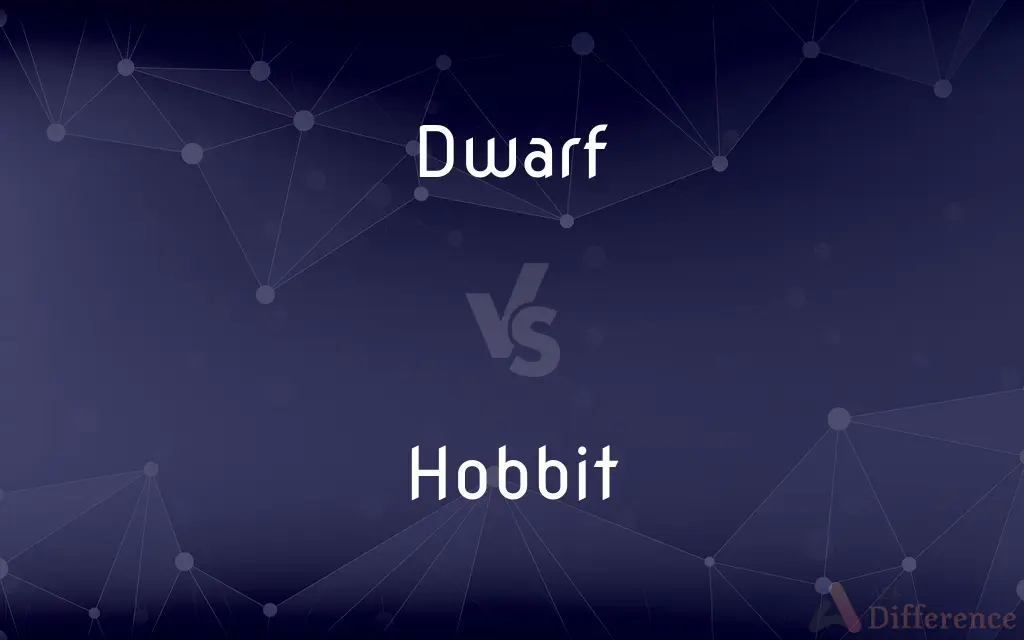Dwarf vs. Hobbit — What's the Difference?
Edited by Tayyaba Rehman — By Urooj Arif — Updated on March 28, 2024
Dwarves are mythical beings known for their strength, craftsmanship, and love of mining, often depicted as short and stout. Hobbits are characterized by their small size, hairy feet, and preference for a peaceful, agrarian lifestyle.

Difference Between Dwarf and Hobbit
Table of Contents
ADVERTISEMENT
Key Differences
Dwarves, found in various mythologies and fantasy works, are typically portrayed as being skilled miners and craftsmen, with a profound connection to the earth and its treasures. They are known for their bravery, strength, and somewhat gruff, secretive nature. In contrast, Hobbits, specifically from Tolkien's Middle-earth, are notable for their small stature, often around half the height of a human, with an aversion to adventure and a fondness for comfort, routine, and simple pleasures.
Dwarves are often depicted as living underground or in mountainous regions, where they forge weapons and mine precious metals, valuing craftsmanship and the creation of enduring artifacts. Hobbits, however, live in the Shire, a region of rolling hills, farmland, and cozy hobbit-holes, emphasizing their love for agriculture, food, and a quiet life away from the broader conflicts of the world.
The culture of dwarves is marked by a love of battle and a capacity for enduring grudges, especially against their enemies. Their societies are structured, hierarchical, and often centered around their kings or lords. On the other hand, Hobbit society is egalitarian, with minimal formal governance, and Hobbits show little interest in the affairs beyond their borders unless directly affected.
In terms of physical appearance, dwarves are often described as being broad, muscular, with beards (including the females, in some tales), embodying the archetypical warrior-miner. Hobbits, conversely, are described as having curly hair, being plump and short, with distinctive hairy feet that allow them to move silently.
While dwarves feature in Norse mythology and various fantasy narratives, highlighting their prowess in battle and metalwork, Hobbits are unique to Tolkien's works, symbolizing the resilience and courage of the ordinary being in the face of overwhelming odds, with their most famous representatives being Bilbo and Frodo Baggins.
ADVERTISEMENT
Comparison Chart
Origin
Various mythologies and fantasy.
J.R.R. Tolkien's Middle-earth.
Lifestyle
Underground/mining, craftsmanship.
Agrarian, peaceful, comfort-loving.
Society
Hierarchical, warrior culture.
Egalitarian, minimal governance.
Physical Traits
Short, stout, often bearded.
Small, plump, hairy feet.
Characteristics
Brave, secretive, love of treasure.
Shy, resilient, enjoy simple life.
Compare with Definitions
Dwarf
Mythical beings known for mining and metalwork.
The dwarves forged legendary weapons in their mountain forges.
Hobbit
Small, peace-loving beings from Tolkien's universe.
Hobbits prefer a quiet life, far from the dangers of the outside world.
Dwarf
Bearded and robust, living in strongholds.
The dwarven stronghold was hidden deep within the mountains.
Hobbit
Notable for their hairy feet and small stature.
Hobbits rarely wear shoes, thanks to the thick, leathery soles of their feet.
Dwarf
Societies led by kings or lords, valuing strength.
Dwarven culture is steeped in honor and the legacy of their ancestors.
Hobbit
Live in cozy hobbit-holes within the Shire.
Bilbo Baggins lived in a hobbit-hole that was the envy of the neighborhood.
Dwarf
Stout, warrior-like creatures with a love for treasure.
Dwarves are renowned for their skill in battle and craftsmanship.
Hobbit
Value simplicity, food, and agriculture.
A perfect day for a hobbit is one filled with two breakfasts and gardening.
Dwarf
Featured in Norse mythology and fantasy literature.
Norse myths depict dwarves as master smiths and creators of magical items.
Hobbit
Symbolize the strength of the ordinary against great odds.
Frodo Baggins, a hobbit, played a pivotal role in the defeat of Sauron.
Dwarf
(in folklore or fantasy literature) a member of a mythical race of short, stocky humanlike creatures who are generally skilled in mining and metalworking.
Hobbit
Hobbits are an imaginary people in the novels of J. R. R. Tolkien. About half average human height, Tolkien presented hobbits as a variety of humanity, or close relatives thereof.
Dwarf
A star of relatively small size and low luminosity, including the majority of main sequence stars.
Hobbit
Homo floresiensis.
Dwarf
Cause to seem small or insignificant in comparison
The buildings surround and dwarf All Saints church
Hobbit
A member of a fictional race of small humanoids with shaggy hair and hairy feet.
Dwarf
A person with a usually genetic disorder resulting in atypically short stature and often disproportionate limbs.
Hobbit
An extinct species of hominin, Homo floresiensis, with a short body and relatively small brain, fossils of which have been recovered from the Indonesian island of Flores.
Dwarf
An atypically small animal or plant.
Hobbit
A Welsh unit of weight, equal to four Welsh pecks, or 168 pounds
Dwarf
A small creature resembling a human, often having magical powers, appearing in legends and fairy tales.
Hobbit
(archaic) An old unit of volume (2 bushels, the volume of 168 pounds of wheat).
Dwarf
A dwarf star.
Hobbit
An imaginary being similar to a person but smaller and with hairy feet; invented by J.R.R. Tolkien
Dwarf
To check the natural growth or development of; stunt
"The oaks were dwarfed from lack of moisture" (John Steinbeck).
Dwarf
To cause to appear small by comparison
"Together these two big men dwarfed the tiny Broadway office" (Saul Bellow).
Dwarf
To become stunted or grow smaller.
Dwarf
(mythology) Any member of a race of beings from (especially Scandinavian and other Germanic) folklore, usually depicted as having some sort of supernatural powers and being skilled in crafting and metalworking, often as short with long beards, and sometimes as clashing with elves.
Dwarf
A person of short stature, often one whose limbs are disproportionately small in relation to the body as compared with typical adults, usually as the result of a genetic condition.
Dwarf
An animal, plant or other thing much smaller than the usual of its sort.
Dwarf tree
Dwarf honeysuckle
Dwarf
(star) A star of relatively small size.
Dwarf
Miniature.
The specimen is a very dwarf form of the plant.
It is possible to grow the plants as dwarf as one desires.
Dwarf
(transitive) To render (much) smaller, turn into a dwarf (version).
Dwarf
(transitive) To make appear (much) smaller, puny, tiny.
The newly-built skyscraper dwarfs all older buildings in the downtown skyline.
Dwarf
(transitive) To make appear insignificant.
Bach dwarfs all other composers.
Dwarf
(intransitive) To become (much) smaller.
Dwarf
To hinder from growing to the natural size; to make or keep small; to stunt.
Dwarf
An animal or plant which is much below the ordinary size of its species or kind.
Dwarf
A diminutive human being, small in stature due to a pathological condition which causes a distortion of the proportions of body parts to each other, such as the limbs, torso, and head. A person of unusually small height who has normal body proportions is usually called a midget.
Dwarf
A small, usually misshapen person, typically a man, who may have magical powers; mythical dwarves were often depicted as living underground in caves.
Dwarf
To hinder from growing to the natural size; to make or keep small; to stunt.
Even the most common moral ideas and affections . . . would be stunted and dwarfed, if cut off from a spiritual background.
Dwarf
To become small; to diminish in size.
Strange power of the world that, the moment we enter it, our great conceptions dwarf.
Dwarf
A person who is abnormally small
Dwarf
A legendary creature resembling a tiny old man; lives in the depths of the earth and guards buried treasure
Dwarf
Make appear small by comparison;
This year's debt dwarves that of last year
Dwarf
Check the growth of;
The lack of sunlight dwarfed these pines
Common Curiosities
Can hobbits and dwarves be found in the same stories?
Yes, in J.R.R. Tolkien's Middle-earth, such as "The Hobbit," dwarves and hobbits are significant characters that interact with each other.
Do dwarves and hobbits get along?
In Tolkien's stories, despite initial misunderstandings or cultural differences, dwarves and hobbits have been known to form strong bonds and friendships.
What is the most notable difference in their societies?
Dwarven societies are hierarchical and focused on warfare and craftsmanship, while Hobbit society is egalitarian, focusing on agriculture and a quiet life.
Are hobbits a part of traditional mythology?
No, hobbits are unique to the works of J.R.R. Tolkien and do not originate from traditional mythology.
Who are some famous dwarves and hobbits?
Famous dwarves include Thorin Oakenshield, while famous hobbits are Bilbo and Frodo Baggins.
What distinguishes dwarves from hobbits?
Dwarves are known for their craftsmanship and warrior nature, living underground, while hobbits are agrarian, love peace, and live in the Shire.
What role do dwarves and hobbits play in fantasy literature?
Dwarves often embody themes of craftsmanship, strength, and resilience, while hobbits represent the courage and significance of the ordinary being.
How do dwarves and hobbits contribute to the world of J.R.R. Tolkien?
They enrich Middle-earth with their unique cultures, perspectives, and roles in the overarching battle between good and evil.
Are there female dwarves in stories?
Yes, though they are less commonly mentioned, female dwarves exist in stories and are sometimes said to have beards.
What is a common misconception about hobbits?
A common misconception is that hobbits are simply younger or smaller humans, when in fact, they are a distinct species in Tolkien's universe.
Share Your Discovery

Previous Comparison
Boatswain vs. Coxswain
Next Comparison
Outrigger vs. AmaAuthor Spotlight
Written by
Urooj ArifUrooj is a skilled content writer at Ask Difference, known for her exceptional ability to simplify complex topics into engaging and informative content. With a passion for research and a flair for clear, concise writing, she consistently delivers articles that resonate with our diverse audience.
Edited by
Tayyaba RehmanTayyaba Rehman is a distinguished writer, currently serving as a primary contributor to askdifference.com. As a researcher in semantics and etymology, Tayyaba's passion for the complexity of languages and their distinctions has found a perfect home on the platform. Tayyaba delves into the intricacies of language, distinguishing between commonly confused words and phrases, thereby providing clarity for readers worldwide.
















































